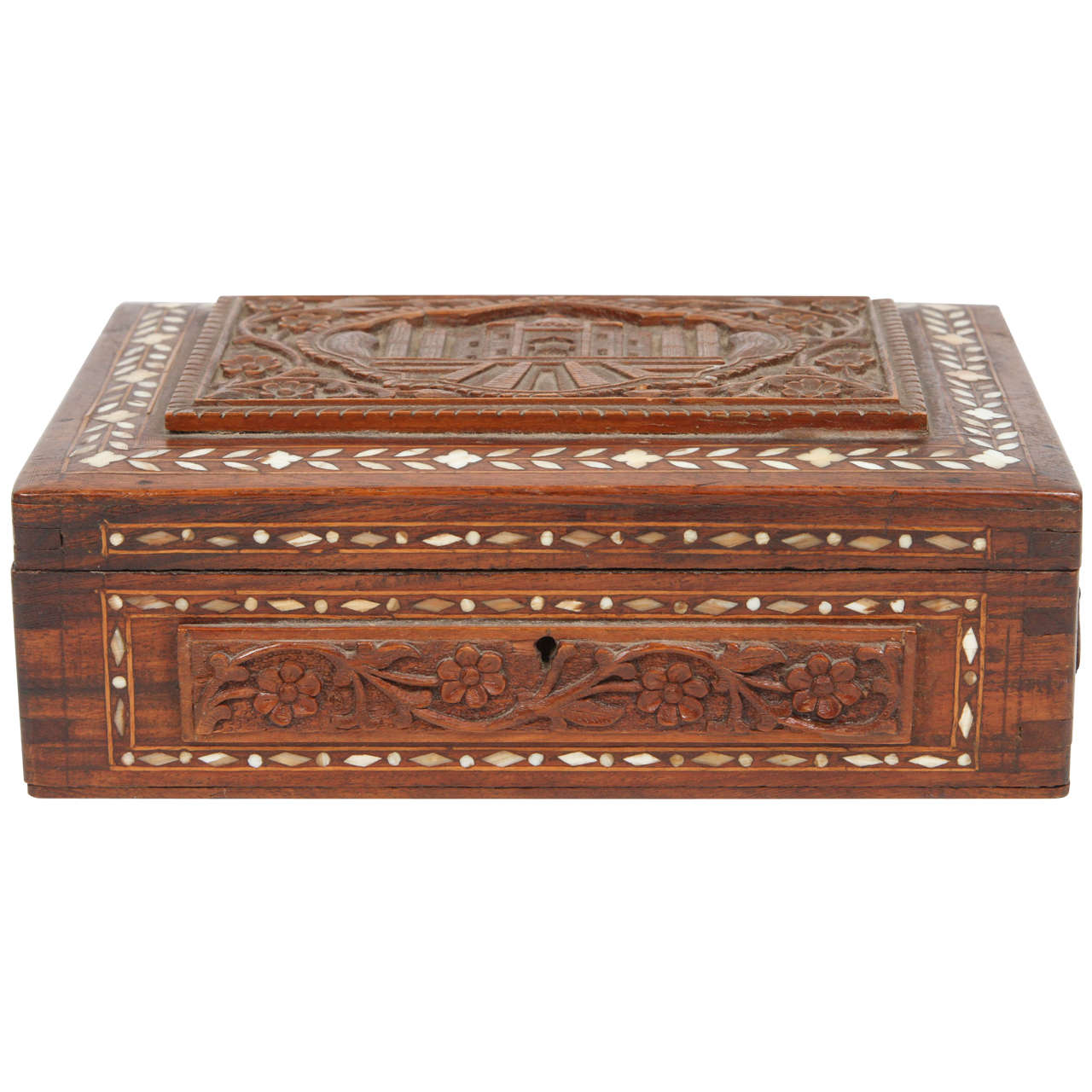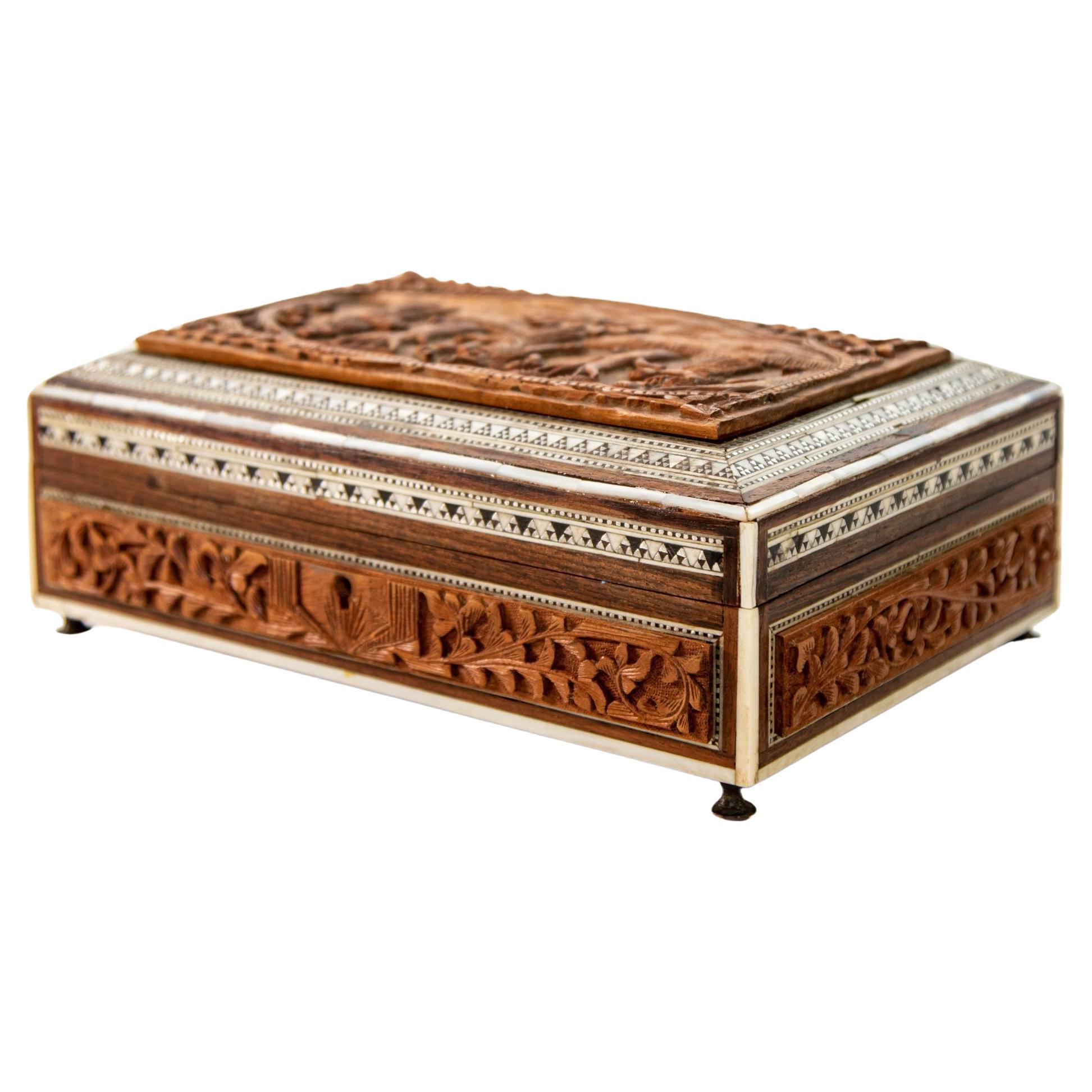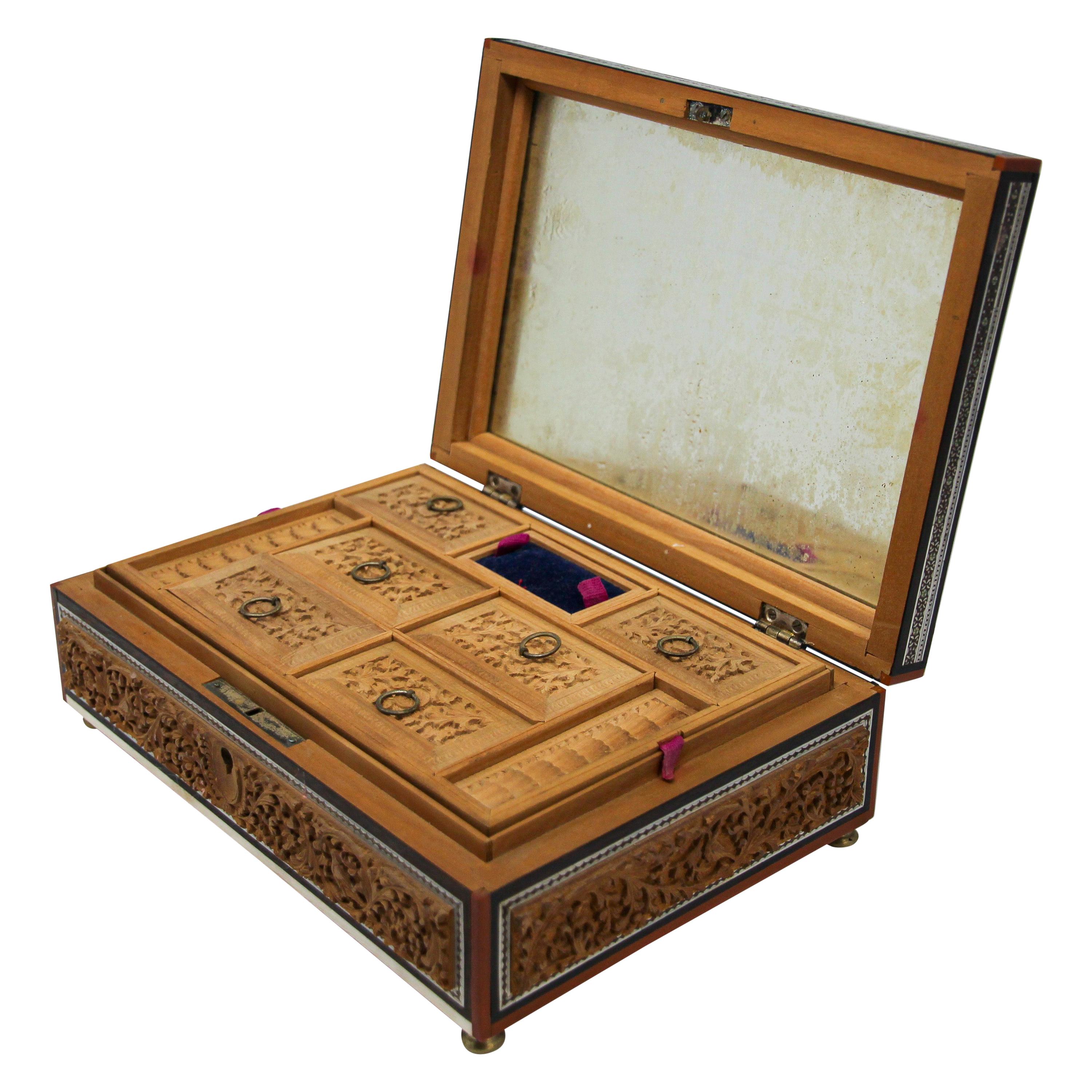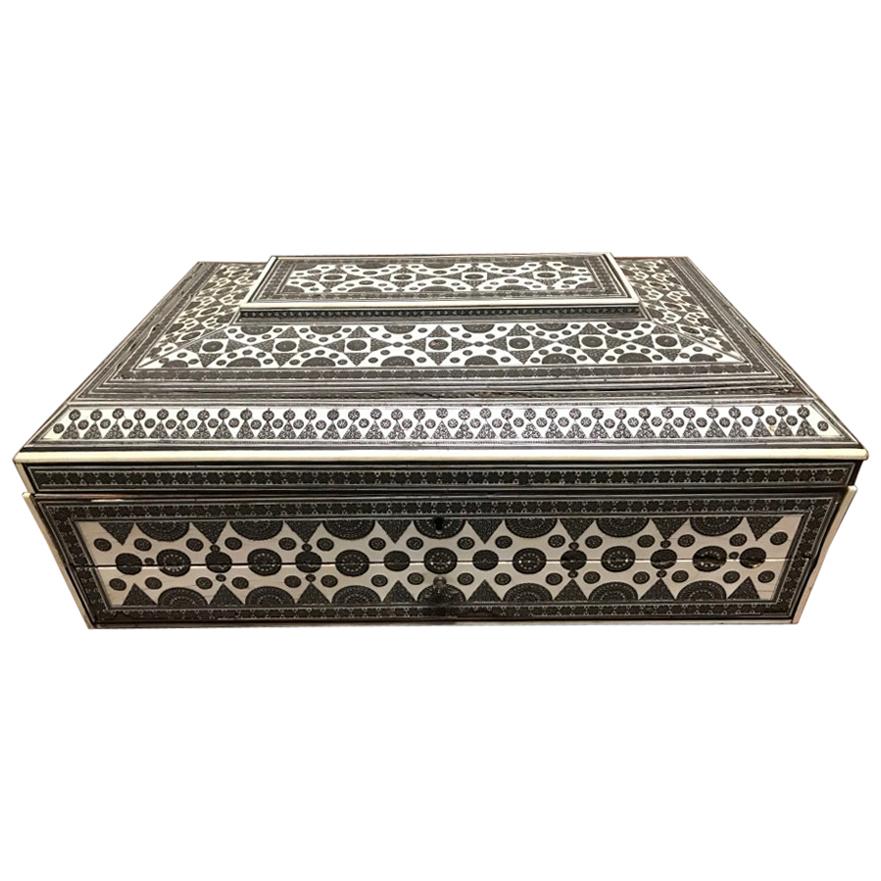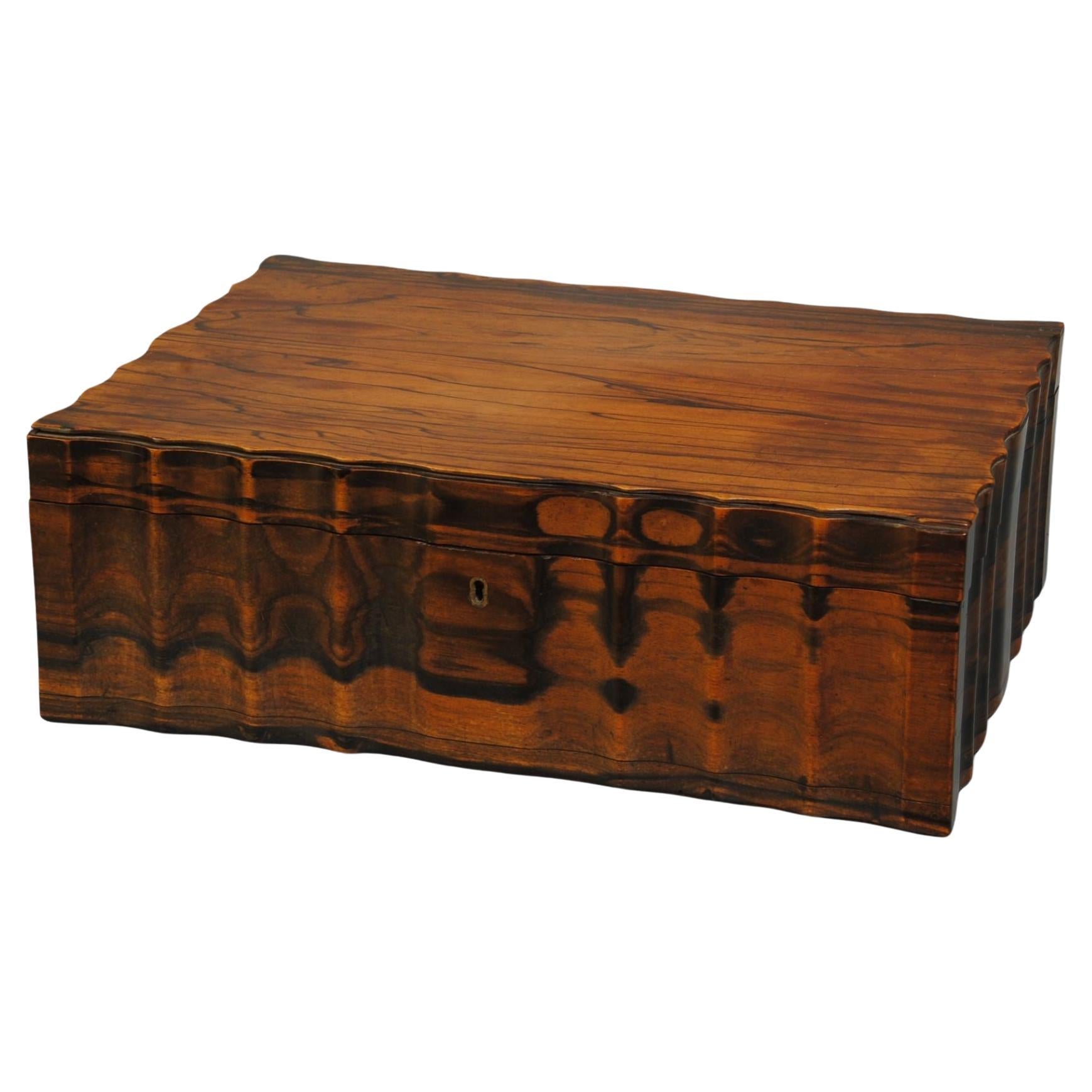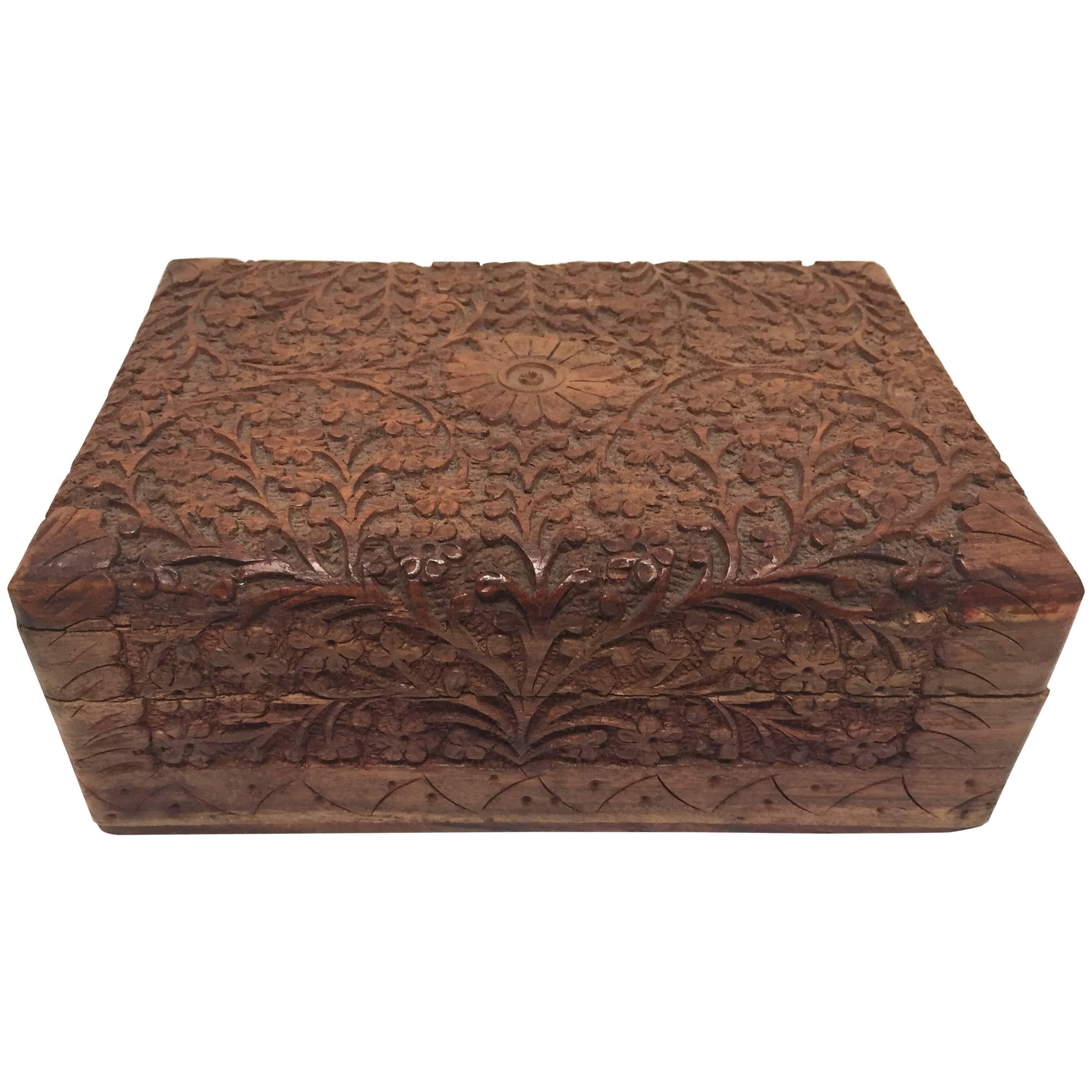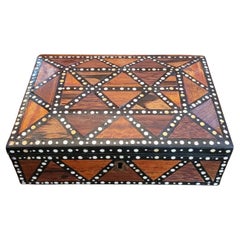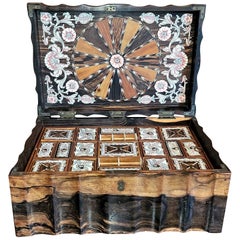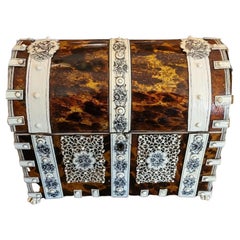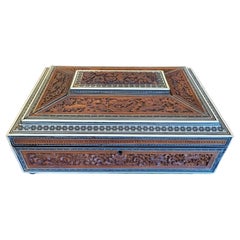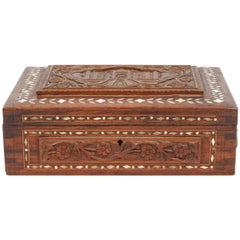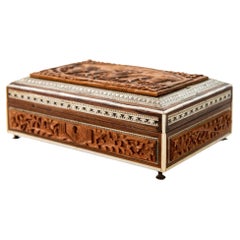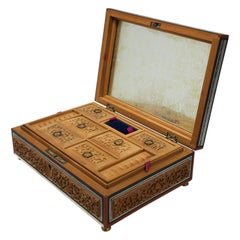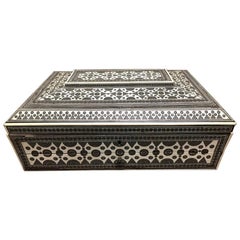Items Similar to 19C Anglo Indian Vizigapatam Stamp Box
Want more images or videos?
Request additional images or videos from the seller
1 of 12
19C Anglo Indian Vizigapatam Stamp Box
$500
£381.08
€435.60
CA$703.47
A$770.63
CHF 405.63
MX$9,197.65
NOK 5,170.74
SEK 4,726.83
DKK 3,253.85
About the Item
Presenting an absolutely gorgeous and very rare 19C Anglo Indian Vizigapatam stamp box.
Made in Colonial India (the Time of the Raj) circa 1860.
Probably made in the region of Vizagapatam.
It is a t/shell box in rectangular shape, covered with bone friezes and banding. The lid slides sideways to reveal the box. Would have been used to store postage stamps.
The lid has an elephant medallion motif.
All hand painted/decorated using lac ink.
In superb condition for it’s age and construction materials. Only one very minor chip to the underside of the shell box as can be seen in the photos.
This is an exceptional example of it’s type !
Anglo Indian boxes were made in India for the English residents from the early part of the 18th century. They were brought back or sent back to England usually by the people who had commissioned them. From the beginning of the nineteenth century they were imported more commercially, although not in any significant numbers until the middle decades. They were very highly valued, especially the early ones, to the extent that the designs were copied on late 19th and early 20th century tins.
The decoration took the form of a border of ivory. The ivory was incised and filled with black lacquer to form intricate floral motifs. In addition to their beauty, the borders also disguised the joints in the ivory and tortoiseshell pieces, which were, because of their nature, of restricted size. Like the earlier boxes, they were edged in decorated ivory, which sealed the end grain and protected it from moisture.
- Dimensions:Height: 0.8 in (2.04 cm)Width: 3.2 in (8.13 cm)Depth: 1.35 in (3.43 cm)
- Style:Anglo-Indian (Of the Period)
- Materials and Techniques:
- Place of Origin:
- Period:
- Date of Manufacture:1860
- Condition:Wear consistent with age and use. Minor losses. Very Good. One very minor loss/chip to the underside of the shell box but this does not in any way detract from it’s beauty and value.
- Seller Location:Dallas, TX
- Reference Number:1stDibs: LU3978125772332
About the Seller
4.8
Gold Seller
Premium sellers maintaining a 4.3+ rating and 24-hour response times
Established in 2015
1stDibs seller since 2018
399 sales on 1stDibs
Typical response time: <1 hour
- ShippingRetrieving quote...Shipping from: Dallas, TX
- Return Policy
More From This Seller
View All19C Anglo Ceylonese Specimen Wood Trinket Box
Located in Dallas, TX
PRESENTING A BEAUTIFUL and RARE 19C Anglo Ceylonese Specimen Wood Trinket Box.
Made in ‘Galle’, Ceylon (now Sri Lanka) circa 1860-80.
Made for the ex...
Category
Antique 19th Century Sri Lankan Anglo-Indian Jewelry Boxes
Materials
Bone, Hardwood, Ebony, Sandalwood
19C Anglo Ceylonese Sewing Box of Museum Quality
Located in Dallas, TX
Presenting an absolutely stunning 19c Anglo Ceylonese sewing box of museum quality.
Made in Ceylon (now Sri Lanka) circa 1860, this is one of the finest sewing boxes of it’s kind that we have ever seen!
The box is made from coromandel wood (an exotic hardwood found in Ceylon) and has a serpentine edging all over the front, back and sides.
Very often the lids/tops of these boxes suffer cracks due to shrinkage but this one is near perfect with no crack in the lid/top. There is some evidence of natural shrinkage but that is around the edges of the lid/top.
It is when you open this box that it reveals it’s true beauty, quality and treasure !
The inside of the lid/top is heavily and beautifully decorated with inlaid bone in scrolling floral patterns which have then been hand painted with red and black ‘lac’ ink. The central medallion is a circle of inlaid specimen exotic hardwoods radiating towards a central bone and hand painted flower. The circle is edged in bone, wood and silver chevrons.
What makes this box Exceptionally rare is that it contains 3 lift out base sections. Normally, there would be a maximum of 2.
The first tray/section is clearly for the purposes ancillary to sewing with a pair of sections with bone spools for thread etc. There are 17 other lidded compartments with each one highly decorated using hand painted bone and specimen woods to replicate tortoiseshell.
The first tray lifts out to reveal a second removeable tray which is made up of a pair of open sections and 8 specimen wood lidded sections each with chevron banding.
The third tray is a smaller tray underneath with 14 lidded compartments each with hand painted bone and specimen wood inlaid lids again, replicating the look of tortoiseshell. Again they are banded with a chevron border.
This is a museum quality piece !
It is in fantastic condition for it’s age with the minor shrinkage to the edges of the lid/top, some finger pulls missing and some very minor cracks to the tray lids and bases but nothing that in any way detracts from the piece. No key.
Dimensions: Closed the box is 16.75 inches wide, 11.25 inches deep and 7.5 inches high
Fully open the box is 16.5 inches high, 16.75 inches wide and 11.4 inches deep
Anglo-Indian and ceylonese boxes: Anglo Indian boxes were made in India for the English residents from the early part of the 18th century. They were brought back or sent back to England usually by the people who had commissioned them. From the beginning of the nineteenth century they were imported more commercially, although not in any significant numbers until the middle decades. They were very highly valued, especially the early ones, to the extent that the designs were copied on late 19th and early 20th century tins.
Anglo-Indian boxes normally consist of 3 main types:-
(1) Most of the best and highest quality Anglo-Indian boxes in the 18th and 19th centuries were made in Vizagapatam, India, renowned for its exquisite craftsmanship in using ivory and tortoiseshell and lac decoration. These are referred to as ‘Vizagapatam Boxes...
Category
Antique Mid-19th Century Sri Lankan Anglo-Indian Decorative Boxes
Materials
Silver
19C Anglo Indian Vizagapatam Bone and Shell Domed Stationery Box
Located in Dallas, TX
PRESENTING A LOVELY 19C Anglo Indian Vizagapatam Bone and Shell Domed Stationery Box – ‘Alice’s Box’.
Made in Vizagapatam, India, circa 1860-80.
We call this one: “Alice’s Box”! It has lived ‘a hard, well used and traveled life’, as is evident from the number of losses and repairs, as is obvious from the photos, especially to the faux ivory panels and bands to the top. The bonus to the loss of the frieze panels to the dome has a ‘bonus’, however, as their loss has revealed the most GORGEOUS faux blonde tortoiseshell underneath!
The box is dome/casket shaped.
The top has 3 bands, with the center one being the original. The 2 side bands are later ivorine.
The faux ivory and hand-painted medallions on the domed lid, have been saved and they depict Hindu Gods, Vishnu and Shiva.
The front and side panels are still in pretty good shape and are decorated with lac ink (indelible ink made from crushed beetles) depicting lovely floral designs.
The domed lid open to reveal a series of open compartments for envelopes, writing paper etc. and one lidded panel for stamps.
Inside the box are 2 paper labels: one probably being the original item ticket and the other with:
” Alice’s address is 272 Ashworth Ave, Toronto 4, Ontario”.
Probably, the original owner? Hence, we call it ‘Alice’s Box’.
What a journey/life this box has had!
Made in India, made its way to Canada, back to Ireland and then to Texas!
This is why, WE LOVE ANTIQUES...
Category
Antique 19th Century Indian Anglo-Indian Decorative Boxes
Materials
Bone, Shell, Sandalwood
19C Anglo Indian Highly Carved Sadeli Mosaic Sarcophagus Sewing Box
Located in Dallas, TX
PRESENTING A GORGEOUS 19C Anglo Indian Highly Carved Sadeli Mosaic Sarcophagus Sewing Box.
Made in Bombay, India circa 1860-80.
Box made of sandalwood with highly carved teak wood reliefs and panels on all sides.
Edged with bone and ebony veneers and glorious sadeli mosaic, made from tiny pieces of faux ivory, pewter, green semi-precious stone.
The box is in a sarcophagus form with domed lid.
The original brass carry handles are on the sides.
The interior is in great condition and consists of a removeable mirror under the lid portion, with the original red velvet lining behind it.
The base is removeable and contains a number of lidded compartments.
6 of the interior lids on the base, are each inlaid with sadeli mosaic banding. The rest are also carved and chased.
The interior is fully complete with 7 lidded faux ivory/bone, thread canisters with sadeli domes and the original bone thimble.
The box sits on 4 brass ball or bun feet with the original velvet lining on the base.
Some minor repairs and losses, but this box is fully complete. This is ‘rare’ as many of these boxes have not survived in such condition!
Included in the sale are 2 photos that were in the box (under the base tray). Interestingly, one of them is a view of downtown Nassau, New Providence (Bermuda) from the early 20C and stamped on the rear. What a ‘journey’ this piece has made! Made in India … travelled to Bermuda, probably via Britain … back to Ireland (where we bought it) …. then to Texas!
These boxes were made by superb Indian craftsmen, specifically for sale to the ruling British elite. These types of boxes, carved padouk and sandalwood, (whilst beautiful and superbly crafted) were of a lesser quality, than the more profusely and intricately mosaic inlay, tortoiseshell and ivory boxes, made for the British ‘Upper Classes’ in the areas of Bombay and Vizagapatam. These type of boxes were much more affordable back in 1880 (and indeed today) and would probably have been bought by mid-level diplomats, civil servants or visitors.
Sewing boxes (in general), were in EVERY Victorian home in Britain in the 19th Century and like other boxes etc were ‘status symbols’ of your place in society! The more ornate the box, the more ‘Upper Class’ you were!
Of it’s type, this one, is one of the very higher quality one’s, than the norm!
SADELI MOSAIC: “Anglo Indian boxes were made in India for the English residents from the early part of the 18th century. They were brought back or sent back to England usually by the people who had commissioned them. From the beginning of the nineteenth century they were imported more commercially, although not in any significant numbers until the middle decades. They were very highly valued, especially the early ones, to the extent that the designs were copied on late 19th and early 20th century tins.
The ancient art of Sadeli Mosaic is said to have been introduced from Shiraz in Persia via Sind to Bombay, a long time before the Anglo Indian boxes were made. It was a technique, which required a high degree of skill and patience. It was executed very lavishly, in that the frequent cuts wasted a great amount of the precious materials used. The workmanship was however more than commensurable to the value of the materials.
Ivory, silver, pewter (or other metals), wood and horn were cut into faceted rods which were bound together to form geometric patterns. When the glue has set, the rods were sliced in transverse sections. This gave the maker a number of angled circular pieces in the original pattern. Several variations of patterns could be achieved by combining the materials in different ways. The ivory was sometimes dyed green to give an extra color.
The mosaic pieces in a combination of patterns, often separated by ivory, ebony, horn or silver stringing were used to veneer sandalwood boxes. In the early boxes, which date from the turn of the 18th to the 19th century, there are large panels of mosaic covering tops and sides of boxes. It took incredible skill to cover such large areas without any shakes or wavering of the pattern. The corners and joins on these boxes are impeccably matched.
The makers (reputed to be Persian) of Sadeli mosaic made in the first two decades of the 19th century displayed a total understanding of the qualities of the different materials they used. They combined substances, which can expand and contract according to atmospheric conditions with others, which are hard and unyielding. The result was a sharp definition of the lines and patterns, which made up the whole design.
On the early boxes the designs look deceptively simple. The fact is, they emerged from a culture, which had mastered geometry and understood how to generate a pattern from a set number of points. The patterns are so harmoniously combined that their incredible complexity is not immediately apparent.
The earliest Sadeli boxes...
Category
Antique 19th Century Indian Anglo-Indian Decorative Boxes
Materials
Bone, Sandalwood, Teak
19C Anglo Indian Carved Teak Wood and Sadeli Mosaic Box
Located in Dallas, TX
PRESENTING A LOVELY 19th century Anglo-Indian Carved Teak Wood and Sadeli Mosaic Box, featuring a carving of a Hunt Scene.
Made circa 1870 in Bombay, India during the Rule of the Br...
Category
Antique Late 19th Century Indian Anglo-Indian Jewelry Boxes
Materials
Silver, Pewter
19c Anglo Indian Highly Carved Teak and Sandalwood Sarcophagus Sewing Box
Located in Dallas, TX
PRESENTING A VERY NICE 19C Anglo Indian Highly Carved Teak and Sandalwood Sarcophagus Sewing Box.
Made in Bombay, India circa 1890-1900.
The box case/body is made of sandalwood wit...
Category
Antique Late 19th Century Indian Anglo-Indian Decorative Boxes
Materials
Bone, Sandalwood, Teak
You May Also Like
19th Century Anglo-Indian Mughal Box
Located in Moreno Valley, CA
19th century Anglo-Indian Mughal wood box, inlaid and hand carved with the Taj Mahal and some flowers all around.
Jewelry box, Anglo-Raj box from India in great condition.
Nice Mughal Bombay Box...
Category
Antique Late 19th Century Indian Anglo Raj Decorative Boxes
Materials
Sandalwood
Antique Anglo-Indian Vizagapatam Jewelry Inlaid Sadeli Footed Box
Located in Moreno Valley, CA
Antique 19th century Anglo-Indian jewelry, trinket footed box, inlay with ebony, mosaic marquetry Sadeli work and a carved Hindu scene on top.
The box case is made from sandalwood wi...
Category
Early 20th Century Indian Anglo-Indian Decorative Boxes
Materials
Bone, Mother-of-Pearl, Wood
Anglo-Indian Footed Box with Lidded Compartments, 19th Century
Located in Moreno Valley, CA
19th century Anglo-Indian wooden box fitted with various compartments finely hand carved.
The top is finely hand carved with the Taj Mahal.
The interior with removable hand carved nine-lidded compartments, the front cover has a mirror, the whole exhibiting very fine workmanship.
This fine late Victorian Anglo-Indian box from India is in great condition for it age.
A beautiful example of an Anglo-Indian fine art...
Category
Antique Late 19th Century Indian Anglo-Indian Decorative Boxes
Materials
Sandalwood
19th Century Anglo-Indian Sadeli Inlaid Work Box Traveling Writing Desk
Located in Stamford, CT
An Anglo Indian bone, ebony and metal inlaid sadeli work box with portable writing desk, Bombay, circa 1850.
The sandalwood body of faceted recta...
Category
Antique Mid-19th Century Indian Anglo-Indian Decorative Boxes
Materials
Metal
A Fine Anglo Indian Coromandel Workbox
Located in Lincolnshire, GB
A fine early 19th century coromandel work box with moulded front design and fitted interior containing a super collection of sea shells.
Ivory registration number 8NEDUS4R.
Category
Antique Early 19th Century Indian Anglo-Indian Decorative Boxes
Materials
Ivory, Wood
Anglo Raj Hand-Carved Decorative Jewelry Box
By Rajhastani
Located in Moreno Valley, CA
Hand-carved Anglo Raj early 20th century carved wood box richly decorated overall with arabesques and floral carving.
Hinged lid shallow relief carving with interior lined with red r...
Category
Early 20th Century Indian Anglo Raj Decorative Boxes
Materials
Sandalwood
More Ways To Browse
Antique Stamps
Antique Anglo Indian Furniture
Stamp Box
Colonial India
Antique Stamp Box
Postage Stamps
Anglo Indian Bone Box
French Casket
Italian Murano Glass Box
Vintage Box India
Maitland Box
Match Box
Antique Travel Box
Chinese Carved Box
Japanese Black Box
Polished Wood Box
Vintage Sterling Silver Objects
Wooden Paint Box
